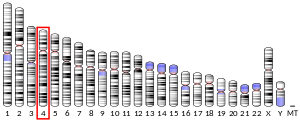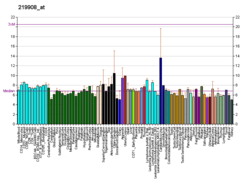DKK2
Dickkopf-related protein 2 is a protein that in humans is encoded by the DKK2 gene.[5][6]
This gene encodes a protein that is a member of the dickkopf family. The secreted protein contains two cysteine rich regions and is involved in embryonic development through its interactions with the Wnt signaling pathway.
It can act as either an agonist or antagonist of Wnt/beta-catenin signaling, depending on the cellular context and the presence of the co-factor kremen 2. Activity of this protein is also modulated by binding to the Wnt co-receptor LDL-receptor related protein 6 (LRP6).[6]
See also
References
- GRCh38: Ensembl release 89: ENSG00000155011 - Ensembl, May 2017
- GRCm38: Ensembl release 89: ENSMUSG00000028031 - Ensembl, May 2017
- "Human PubMed Reference:". National Center for Biotechnology Information, U.S. National Library of Medicine.
- "Mouse PubMed Reference:". National Center for Biotechnology Information, U.S. National Library of Medicine.
- Krupnik VE, Sharp JD, Jiang C, Robison K, Chickering TW, Amaravadi L, Brown DE, Guyot D, Mays G, Leiby K, Chang B, Duong T, Goodearl AD, Gearing DP, Sokol SY, McCarthy SA (Dec 1999). "Functional and structural diversity of the human Dickkopf gene family". Gene. 238 (2): 301–13. doi:10.1016/S0378-1119(99)00365-0. PMID 10570958.
- "Entrez Gene: DKK2 dickkopf homolog 2 (Xenopus laevis)".
- Song, Yaolin; Boncompagni, Ana C.; Kim, Sang-Seok; Gochnauer, Heather R.; Zhang, Yuhang; Loots, Gabriela G.; Wu, Dianqing; Li, Yulin; Xu, Mingang; Millar, Sarah E. (December 2018). "Regional Control of Hairless versus Hair-Bearing Skin by Dkk2". Cell Reports. 25 (11): 2981–2991.e3. doi:10.1016/j.celrep.2018.11.017. PMC 6345517. PMID 30509557.
Further reading
- Wu W, Glinka A, Delius H, Niehrs C (2001). "Mutual antagonism between dickkopf1 and dickkopf2 regulates Wnt/beta-catenin signalling". Curr. Biol. 10 (24): 1611–4. doi:10.1016/S0960-9822(00)00868-X. PMID 11137016.
- Mao B, Wu W, Li Y, et al. (2001). "LDL-receptor-related protein 6 is a receptor for Dickkopf proteins". Nature. 411 (6835): 321–5. doi:10.1038/35077108. PMID 11357136.
- Li L, Mao J, Sun L, et al. (2002). "Second cysteine-rich domain of Dickkopf-2 activates canonical Wnt signaling pathway via LRP-6 independently of dishevelled". J. Biol. Chem. 277 (8): 5977–81. doi:10.1074/jbc.M111131200. PMID 11742004.
- Brott BK, Sokol SY (2002). "Regulation of Wnt/LRP signaling by distinct domains of Dickkopf proteins". Mol. Cell. Biol. 22 (17): 6100–10. doi:10.1128/MCB.22.17.6100-6110.2002. PMC 133995. PMID 12167704.
- Strausberg RL, Feingold EA, Grouse LH, et al. (2003). "Generation and initial analysis of more than 15,000 full-length human and mouse cDNA sequences". Proc. Natl. Acad. Sci. U.S.A. 99 (26): 16899–903. Bibcode:2002PNAS...9916899M. doi:10.1073/pnas.242603899. PMC 139241. PMID 12477932.
- Mao B, Niehrs C (2003). "Kremen2 modulates Dickkopf2 activity during Wnt/LRP6 signaling". Gene. 302 (1–2): 179–83. doi:10.1016/S0378-1119(02)01106-X. PMID 12527209.
- Clark HF, Gurney AL, Abaya E, et al. (2003). "The secreted protein discovery initiative (SPDI), a large-scale effort to identify novel human secreted and transmembrane proteins: a bioinformatics assessment". Genome Res. 13 (10): 2265–70. doi:10.1101/gr.1293003. PMC 403697. PMID 12975309.
- Gerhard DS, Wagner L, Feingold EA, et al. (2004). "The status, quality, and expansion of the NIH full-length cDNA project: the Mammalian Gene Collection (MGC)". Genome Res. 14 (10B): 2121–7. doi:10.1101/gr.2596504. PMC 528928. PMID 15489334.
- Kuphal S, Lodermeyer S, Bataille F, et al. (2006). "Expression of Dickkopf genes is strongly reduced in malignant melanoma". Oncogene. 25 (36): 5027–36. doi:10.1038/sj.onc.1209508. PMID 16568085.
This article is issued from Wikipedia. The text is licensed under Creative Commons - Attribution - Sharealike. Additional terms may apply for the media files.




